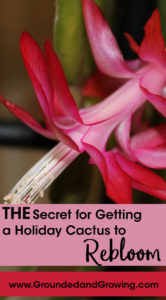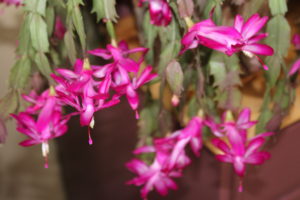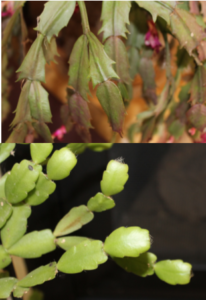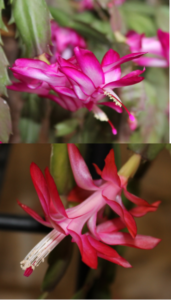 Holiday cactus will bloom each year by paying attention to a couple of key conditions that require very little effort.
Holiday cactus will bloom each year by paying attention to a couple of key conditions that require very little effort.
This post contains affiliate links for your shopping convenience.

Thanksgiving cactus (Schlumbergera truncate) blooming in my kitchen. This particular plant was near death two years ago after struggling to survive in my husband’s dimly lit office.
Holiday cactus is certainly a lesser known holiday plant compared to the poinsettia. But if you love indoor blooming plants and they don’t love you (because you kill them or they never rebloom), a Holiday cactus is for you. They are one of the easiest houseplants to coax into reblooming, and if you’re lucky you just might find one on the clearance table in the midst of post-Holiday sales.
Holiday cacti sold in the fall are often called Christmas cacti, but not every Holiday cactus is a Christmas cactus. There are two species of Holiday cactus, named for the Holiday closest to when they typically bloom: Thanksgiving cactus (Schlumbergera truncata), and Christmas Cactus (Schlumbergera bridgesii). In fact, Thanksgiving cacti are most of what’s sold in stores each fall. An older name that you still sometimes see is Zygocactus.
Do you have a Thanksgiving or a Christmas cactus?

Flattened leaf-like segments of Thanksgiving cactus are pointed (top picture) while Christmas cactus have rounded segments (bottom picture)
- Thanksgiving cacti have flat leaf-like stem segments with pointed edges, while Christmas cacti have rounded edges.
- When allowed to rebloom naturally (as opposed to having flowering controlled by a greenhouse environment), Thanksgiving cacti flower in late November, and Christmas cacti flower in late December.
- Thanksgiving cactus flowers have more petals on one side of the flower; Christmas cactus flowers have petals evenly distributed.

Thanksgiving cactus has flowers with petals predominantly on one side (top picture); Christmas cactus flowers have petals more evenly distributed (bottom picture).
Holiday cacti both produce similar, trumpet-like flowers with layered petals. Christmas cacti are a shade of red, while Thanksgiving cacti come in a much wider range of colors like white, and shades of pink, purple, reds and salmons. Occasionally you may see yellow. Some cultivars have been bred to have frills or ruffles on the petals.
Holiday cacti are native to tropical environments in the Organ mountains of Brazil, not the desert like the name “cactus” suggests. They are forest cacti accustomed to growing in the lush understory of tropical rainforests.
Caring for Holiday cacti are different than caring for desert cacti:
1. Some people wrongly assume that you should rarely water Holiday cacti since they are cacti. Too little water will cause wilting, flower bud drop and even death of the whole plant in extreme cases.
2. Native to the rain forest, Holiday cacti tolerate much more water than you might expect, storing it in their succulent, flat leaf-like stems. However, too much water will cause root rot.
3. Unlike their desert relatives, Holiday cacti cannot tolerate intense full sun. Full sun will burn the leaves.
4. They perform far better under indirect but bright light. A south or western exposure is best for the winter months; a shaded spot outside is ideal for the summer months.
5. Holiday cacti are happy in typical winter home temperatures, but their flowers will last longer in a cooler location (50 to 55°F).
6. Drafts or sudden changes in lighting or watering schedules may cause a Holiday cactus to drop unopened flower buds. If you must alter the environment of a Holiday cactus, do it as gradually as is reasonably possible.
7. Most Holiday cacti seem to do better when a little root-bound in their pot. But if you feel you must re-pot, use a potting mix that is well-draining, such as that designed for cacti.
8. I find that some commercial cactus mixes are too sandy for Holiday cacti, so I mix about two parts cactus mix to one part general purpose potting mix to increase the organic matter. The new mix is still well-draining, and my Holiday cacti grow and bloom very well in it.
Helpful Supplies for Healthy Holiday Cacti
- Soil Mix— Typically I mix two parts cactus soil mix to one part all-purpose potting mix. Neither mix needs to have fertilizer already mixed in. It’s nice, but not absolutely necessary.
- Lighting— I found this compact LED grow light with adjustable goosenecks and I absolutely love it! It fits on my kitchen counter and includes a timer. If your indoor lighting is questionable, add this light and your plants will love you for it!
- Fertilizer— Pick a general purpose fertilizer and use it throughout the summer. Liquid, water-soluble powder, or solid spike formulas are all great. Fertilizing while the plant is in bud and bloom can cause flower buds to drop. Also, fertilizing in winter without adequate light can lead to weak growth susceptible to pests and disease.
- Rooting Hormone— While not absolutely necessary for propagating Holiday cacti, it sure does speed the process along. Either powder or gel formulas work well.
- Display options— If you need a little help giving your plant access to available natural light, try these suction cup window shelves. I adore them. They hold quite a bit and don’t budge! Holiday cacti can also make a great hanging plant (& gift!), so try my directions for making macramé plant hangers while you’re at it!
Holiday cacti are great pass-along plants.
They grow with distinct joints between flattened leaf-like stem segments and can be easily separated. If you let the broken end dry out for a day or two, then plant it in a pot of its own, it will root readily. Planting multiple segments in one pot will help produce a fuller looking display and will not hurt the individual plants.
When we got married in 2006, a friend gave us a Holiday cactus started from the plant her great-grandmother grew. This friend was in her sixties at the time, so that plant had to be over a hundred years old. These really are plants with longevity, not disposable after they finish blooming like some blooming houseplants can be.
My busy schedule revealed the secret that convinced my own Thanksgiving cactus to produce tons of flowers.
I purchased my first Thanksgiving cactus while I was in high school; it occasionally threw out a bloom or two in the years after I bought it, but it was nothing impressive. I was discouraged when I read the plant needed 12-14 hours of darkness each day for 6-8 weeks to trigger blooming, and interrupting this schedule could send you back to square one. I settled for the occasional bloom the plant managed to produce.
That same plant purchased in high school was still alive and kicking when I started graduate school at the University of Illinois. My Holiday cactus spent what was left of that first summer on my apartment’s balcony along with my other houseplants.
As that first fall semester wore on, the weather turned cooler. I was beyond busy with my course and research work. Temperatures hadn’t dipped below freezing yet, but my plants were still outside well beyond the point where I would have usually brought them inside. I remember rushing home one day when the forecast predicted frost. As I hustled to bring all my plants in, I noticed flower buds all over my Holiday cactus. Not just a few, but the end of every arching branch had one or even two buds.
The cooler and longer nights of early fall are environmental triggers for flower development in Holiday Cacti. Cooler nights (50-55°F) eliminate the need to have a rigid light/dark schedule. As a result of this happy accident, I routinely leave my Holiday cacti out on our porch well into the fall. When I bring them in, I enjoy weeks of gorgeous flowers.
As a gardener with limited time for gardening, I love plants that don’t just survive but thrive on neglect. Any plant that also blooms despite my sporadic attention is a must-have at my house.
When you’re perusing the post-Holiday sales this year, don’t be afraid to pick up an out-of-bloom Holiday cactus. It should reward you with blooms next year if you follow these easy directions.
If you liked this post, please subscribe to Grounded and Growing today and receive your copy of “15 Tips to Become a '15 Minute Gardener'” so you can spend less time working ON your garden and more time enjoying being IN your garden.! It’s absolutely free. When you join the Grounded and Growing community, you’ll finally take the garden off your “To-Do” list and allow yourself time to enjoy your garden and savor the peace and serenity there. I tell subscribers about new posts as soon as I hit ‘publish’ and send weekly-ish updates on what’s going on in my garden– good, bad AND ugly.

All Rights Reserved. © 2019 Jennifer Schultz Nelson
This was an excellent blog that really educated me about how to properly care for my ” Christmas” cactus. I’ve had it for over a year now and with this new knowledge hoping to enjoy it for many more years. Thank you.
Thanks Linda! I’m glad you found the information helpful!